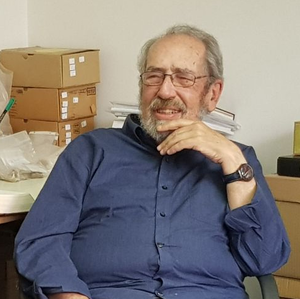Gabriel Barkay

Gabriel Barkay (Hebrew: גבריאל ברקאי; sometimes transcribed from the Hebrew Gavriel Barkai) is an Israeli archaeologist.
Born in 1944 in Hungary, he immigrated to Israel in 1950.[2]
Barkay studied archaeology, comparative religion and geography at Tel Aviv University, graduated summa cum laude, and received his PhD in Archaeology from the same university in 1985.[2] His dissertation was about LMLK seal impressions on jar handles. He participated in the Lachish excavations with David Ussishkin. His academic areas of interest include the archaeology of Jerusalem, biblical archaeology, burials and burial customs, art, epigraphy, and glyptics in the Iron Age.
In 1968-71, Barkay and David Ussishkin surveyed the Silwan necropolis from the time of the Judean Monarchy during the Iron Age, containing 50 rock-cut tombs of Judahite high government officials.[3] Barkay also excavated the Iron Age tombs on the grounds of the École Biblique in the early 1970s.
Dr. Barkay’s most famous discoveries are two small silver scroll amulets containing the priestly benediction from the Book of Numbers (Numbers 6:24-26), which he discovered in 1979 in a First Temple Period tomb at Ketef Hinnom. These amulets contain the oldest surviving biblically-related inscription discovered to date, dating back to the seventh century BCE and are to-date the only archaeological proof that passages from the Hebrew Bible as we know them were in circulation in the First Temple Period.
In 2005, together with archaeologist Zachi Zweig, Barkay established the Temple Mount Sifting Project, a project funded by the Ir David Foundation and dedicated to recovering archaeological artifacts from 400 truckloads of earth removed from the Temple Mount by the Waqf and Israeli Islamic movement during 1996–2001. The construction included the establishment of the underground so-called El-Marwani Mosque at an ancient structure known since medieval times as Solomon’s Stables, excavating a huge pit as an entrance to the structure, and reducing the platform level at the area north to the entrance.[4]
One of the findings of this project is a 7th-century BCE bulla (round clay seal affixed to documents), which became known as the “Bethlehem Seal”. Dr. Barkay offered the first translation of the Hebrew three-line inscription: “In the 7th year, Bethlehem, for the king”.[2]
Barkay points out to the findings from the Byzantine period—mainly ceramics and coins, including rare coins, but also architectural elements, some from churches. Some scholars claim that the Temple Mount was left bare by the Christian rulers, to conform with Jesus’ prophecy that not a stone of the Temple complex will be left standing (Mark 13:2, Luke 21:6, Matthew 24:2) and in order to emphasise the Church of the Resurrection, but in Barkay’s assessment, the findings prove that “in the Byzantine era the Temple Mount was a center of activity”, as the place may have held churches and a marketplace.[5][6]
